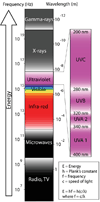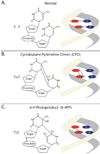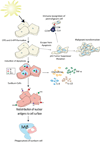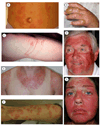Light, including ultraviolet
- PMID: 20018479
- PMCID: PMC2835849
- DOI: 10.1016/j.jaut.2009.11.011
Light, including ultraviolet
Abstract
Ultraviolet (UV) light is intricately linked to the functional status of the cutaneous immune system. In susceptible individuals, UV radiation can ignite pathogenic inflammatory pathways leading to allergy or autoimmunity. In others, this same UV radiation can be used as a phototherapy to suppress pathogenic cutaneous immune responses. These vastly different properties are a direct result of UV light's ability to ionize molecules in the skin and thereby chemically alter them. Sometimes these UV-induced chemical reactions are essential, the formation of pre-vitamin D(3) from 7-dehydrocholesterol, for example. In other instances they can be potentially detrimental. UV radiation can ionize a cell's DNA causing adjacent pyrimidine bases to chemically bond to each other. To prevent malignant transformation, a cell may respond to this UV-induced DNA damage by undergoing apoptosis. Although this pathway prevents skin cancer it also has the potential of inducing or exacerbating autoreactive immune responses by exposing the cell's nuclear antigens. Ultraviolet-induced chemical reactions can activate the immune system by a variety of other mechanisms as well. In response to UV irradiation keratinocytes secrete cytokines and chemokines, which activate and recruit leukocytes to the skin. In some individuals UV-induced chemical reactions can synthesize novel antigens resulting in a photoallergy. Alternatively, photosensitizing molecules can damage cells by initiating sunburn-like phototoxic reactions. Herein we review all types of UV-induced skin reactions, especially those involving the immune system.
Published by Elsevier Ltd.
Figures









References
-
- Palmer CN, Irvine AD, Terron-Kwiatkowski A, Zhao Y, Liao H, Lee SP, Goudie DR, Sandilands A, Campbell LE, Smith FJ, O'Regan GM, Watson RM, Cecil JE, Bale SJ, Compton JG, DiGiovanna JJ, Fleckman P, Lewis-Jones S, Arseculeratne G, Sergeant A, Munro CS, El Houate B, McElreavey K, Halkjaer LB, Bisgaard H, Mukhopadhyay S.McLean WH. Common loss-of-function variants of the epidermal barrier protein filaggrin are a major predisposing factor for atopic dermatitis. Nat Genet. 2006;38:441–446. - PubMed
-
- Svobodova A, Walterova D.Vostalova J. Ultraviolet light induced alteration to the skin. Biomed Pap Med Fac Univ Palacky Olomouc Czech Repub. 2006;150:25–38. - PubMed
-
- Cleaver JE. Defective repair replication of DNA in xeroderma pigmentosum. Nature. 1968;218:652–656. - PubMed
-
- Tommasi S, Denissenko M.F.Pfeifer GP. Sunlight induces pyrimidine dimers preferentially at 5-methylcytosine bases. Cancer Res. 1997;57:4727–4730. - PubMed
-
- Ziegler A, Jonason AS, Leffell DJ, Simon JA, Sharma HW, Kimmelman J, Remington L, Jacks T.Brash DE. Sunburn and p53 in the onset of skin cancer. Nature. 1994;372:773–776. - PubMed
Publication types
MeSH terms
Substances
Grants and funding
LinkOut - more resources
Full Text Sources
Other Literature Sources
Medical

